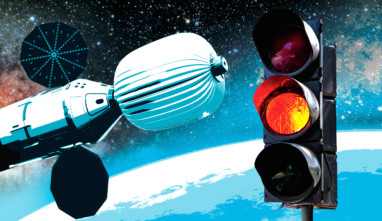
Two major accidents in American space-related programmes occurred within less than three days, between October 28 and 31. In the first one, a rocket exploded seconds after liftoff from a space flight facility; luckily, it resulted in no casualties, but there were millions of dollars in losses, as it was carrying equipment and supplies for the International Space Station. The second accident was the crash of the SpaceShipTwo craft, which was being tested by Virgin Galactic for space tourism. One pilot died and another was injured in the crash. Seeing the images — and particularly the video of the rocket explosion — I was reminded of past space-programme accidents, particularly the two space shuttle explosions of 1986 and 2003. I was also immediately concerned that the public, and perhaps even some officials, might lose their excitement over the UAE’s ambitious space programme, especially when one knows how much Mars missions have been “cursed” in the past.
In the column that I wrote immediately after the announcement that the UAE plans a space agency and a mission to Mars, I likened the announcement to John F. Kennedy’s to-the-moon speech. I was again reminded of it, recalling his statement: “We choose to go to the moon in this decade and do the other things, not because they are easy, but because they are hard.”
Indeed, space programmes have proven quite costly in monies and in human sacrifices. Many rockets have exploded at launch since the early sixties. The most famous case is the Challenger shuttle accident in 1986, with the death of seven astronauts, including a school teacher. Several spacecraft have crashed during their return to earth, like the Columbia shuttle, which was bringing back seven astronauts after two successful weeks in space. The Soviets too had their big share of losses, with a number of astronauts dying in failed returns.
There have also been some close calls, as in the case of the Apollo 13 mission, which went from “disaster in the making” to “Nasa’s finest hour”, when engineers and scientists worked out a solution to safely bring back the astronauts on that crippled spacecraft.
Missions to Mars have been the most difficult to master, though no human losses have resulted from them. Indeed, most failures have occurred after launch, and the spacecraft have all been unmanned. Between 1960 and 2000, 25 missions to Mars failed out of 32, a depressing rate of 78 per cent. However, between 2000 and 2010, the rate fell to 12.5 per cent, only 1 failure in 8 attempts. Indeed, Mars missions have now become spectacularly successful, with Nasa’s impressive landing of Curiosity, and most recently India’s Mangalyaan taking orbit around the red planet and sending back first-rate pictures and data.
What has caused all those failures, and how can we learn to avoid and overcome them?
Launch accidents are most often attributed to deficiencies in rocket design, engine structural problems (as, it appears, in this recent rocket explosion), or unsuitable weather conditions (as, famously, in the Challenger accident). We can and have been learning to avoid these by conducting more meticulous tests and inspections. Relying on old engines and technologies and cutting corners is a sure recipe for disaster, as we have learned at great cost.
Drop in rates of failure
In space, the most common problem for Mars missions has been radio communication failures or programming errors in arrival manoeuvres. Much progress and improvement have been made on both issues, as attests the drop in failure rates in the past decade. One must simply be up to date on the latest space technologies and mission procedures and controls.
Now, what implications will the latest accidents have on space programmes?
The first effect is psychological, as is always the case when accidents happen in close succession. In such instances, people tend to generalise and inflate problems, when in fact the cases are totally unrelated and the general situation is far from disastrous. But the more serious consequence of these accidents will be the public’s insistence on a full review of space tourism programmes, for these will carry humans who will have paid huge fares and spent much time training for such trips. The public will not accept any explosions with lay people on board. The Challenger disaster was so traumatic to America — and resulted in the grounding of the space shuttle for over two years and a full technical overhaul — because it carried a school teacher and was being broadcast live on TV. A review and delay in space tourism programmes is not a bad thing; safety first, as they say!
Another effect will be a serious review of the outsourcing of rocket launching to commercial companies, such as the Orbital Sciences Corp., which carried out the recent failed launch. It is true that no casualties were recorded in this accident, and regardless of who will pay for the material losses and delays of the programme, one must ensure that such risks are as close to zero as possible.
Learning from setbacks, picking oneself up, looking upward, and moving on with determination is what characterises the human spirit of progress. And as Pierre Corneille eloquently put it centuries ago, “to win without risk is to triumph without glory.”
Nidhal Guessoum is a professor of physics and astronomy at the American University of Sharjah. You can follow him on Twitter at: www.twitter.com/@NidhalGuessoum.










